EU-Agrarpolitik: Endlich die „Förderpraxis der Zerstörung“ ändern/EU agricultural policy: A change to destructive funding practices is long overdue [deu/eng]

©Plainpicture / Mischa Keijser
Click here for the english version
Die Geschäftsführerin des Öko-Instituts, Anke Herold, kommentiert in ihrem Blogbeitrag, warum die derzeitige Neuverhandlung der EU-Agrarsubventionen nicht zum Klimaschutz beitragen wird. Dabei hat die EU in keinem anderen Sektor einen so großen direkten Einfluss auf die Emissionen wie in der Landwirtschaft.
[caption id="attachment_1322" align="alignright" width="300"] Anke Herold ist Geschäftsführerin vom Öko-Institut.[/caption]
Anke Herold ist Geschäftsführerin vom Öko-Institut.[/caption]
Nach den vollmundigen Ankündigungen von Kommissionspräsidentin von der Leyen, die EU-Klimaziele zu erhöhen, hatten viele gehofft, dass den Worten nun auch endlich Taten folgen. Doch zu früh gefreut: die Beschlüsse der europäischen Agrarminister und des europäischen Parlaments zur Gemeinsamen Agrarpolitik von Ende Oktober 2020 sind ein klarer Rückschritt für den Schutz von Klima, Biodiversität, Wasser und Tieren. Seitdem hat ein zähes Ringen um einige zarte Verbesserungen im Trilog-Verfahren zwischen Kommission, Ministerrat und Europaparlament begonnen.
In keinem anderen Sektor hat die EU einen so hohen direkten Einfluss auf die Emissionen wie in der Landwirtschaft:
Die Gemeinsame Agrarpolitik (GAP), ein Politikbereich der Europäischen Union, legt die Zahlungen an die landwirtschaftlichen Betriebe fest. Für die nächsten sieben Jahre werden 387 Milliarden Euro verteilt, ein Drittel des gesamten EU-Haushalts.
In keinem anderen Sektor gibt es so komplett unnötige Emissionen wie in der Landwirtschaft. Ungefähr 40 Prozent der Emissionen aus der Landwirtschaft entstehen durch überschüssige Stickstoffeinträge. Es ist seit Jahrzehnten bekannt, dass in Europa und in Deutschland mehr Stickstoff auf die Felder ausgebracht wird als die Pflanzen zum Wachstum brauchen.
Kein anderer Sektor hat ein so großes CO2-Einbindungspotenzial wie die Landwirtschaft: Mit der Wiedervernässung von drainierten Mooren und der moorschonenden Bewirtschaftung der Böden könnten wir große Mengen an CO2 aus der Atmosphäre einbinden und gleichzeitig Fortschritte für Naturschutz und die Biodiversität erreichen.
Die Gesetzesvorlagen zur GAP, die nun abschließend beraten werden, werden die Landwirtschaft nicht auf einen Pfad bringen, der mit dem Ziel der Klimaneutralität bis 2050 kompatibel ist.
Konstruktion: Die Zwei Säulen der Gemeinsamen Agrarpolitik
1. Die Direktzahlungen aus EU-Mitteln
Die erste Säule der Direktzahlungen wird zwar um 11 Prozent gekürzt, bleibt aber weiter vorrangig. 60 Prozent der Direktzahlungen sind weiterhin nur an die Größe der bewirtschafteten Fläche und Produktionsmenge gebunden. Ein Drittel dieser Direktzahlungen geht an 1,5 Prozent der Subventionsbezieher.
Der große Widerspruch ist, dass die meisten Mittel weiterhin über flächengebundene Direktzahlungen vergeben werden. Auch wenn diese Zahlungen an Auflagen gebunden sind, eignen sich Direktzahlungen nicht, um Klimaschutz, Tierwohl oder Umweltschutz voran zu bringen. Das hat sich bereits seit langem in der Umsetzung gezeigt.
Eco-Schemes sind unterfinanziert und verwässert
Nur voraussichtlich 30 Prozent des Direktzahlungsbudgets sind für sogenannte Eco-Schemes mit Klima und Umweltmaßnahmen reserviert. Der Ministerrat möchte sogar nur 20 Prozent der Mittel für die Umweltmaßnahmen festlegen. Diese „Öko-Regelungen“ sind einjährige Umweltmaßnahmen, die die Mitgliedstaaten festlegen müssen. Für diese bekommen die Landwirtinnen und Landwirte Zahlungen aus der ersten Säule, wenn sie diese Maßnahmen freiwillig umsetzen. Für die Ausgestaltung dieser Eco-Schemes sind weitgehend die Mitgliedstaaten zuständig.
Entgegen des Kommissionsvorschlags möchte der Ministerrat, dass die Eco-Schemes erst nach 2025 eingeführt werden. Das heißt: Der Klima- und Umweltschutz wird weiter in die Zukunft verschoben.
Was als Umweltschutz bei den Eco-Schemes zählt, wurde sowohl vom Ministerrat als auch vom Europäischen Parlament verwässert. Bereitgestellt Gelder werden auch mit der Erreichung anderer Ziele verknüpft: Vor allem beim Vorschlag des Parlaments sollen die Umweltmaßnahmen auch gleichzeitig die ökonomische Leistungsfähigkeit der Landwirte steigern. Die Liste der Agrarumweltmaßnahmen wurde erheblich erweitert und dabei Maßnahmen integriert, die hinsichtlich ihrer positiven Umweltwirkungen umstritten sind. Beispielsweise soll die Präzisionslandwirtschaft gefördert werden, die die Pestizide zwar zielgenauer einsetzt, aber nicht das Ziel hat, diese zu reduzieren oder in empfindlichen Gebieten einzuschränken. Das Europäische Parlament möchte auch Tierschutzmaßnahmen in die Eco-Schemes mit einbringen, ohne aber die Mittel zu erhöhen.
2. Die Zahlungen für ländliche Entwicklung
Die zweite Säule der GAP hat unter anderem das Ziel, die ländliche Entwicklung zu fördern. In der jetzigen GAP sind hier die Agrarumwelt- und Klimamaßnahmen verortet. Diese werden aus dem „Europäischen Landwirtschaftsfonds für Entwicklung des ländlichen Raums“ finanziert, müssen aber mit regionalen oder nationalen Mitteln kofinanziert werden. Mindestens 30 Prozent der Mittel müssen laut jetzigem Vorschlag für Agrarumwelt- und Klimamaßnahmen, den ökologischen Landbau oder Zahlungen im Rahmen von Natura 2000 verwendet werden. Natura 2000 ist ein EU-weites Netz von Schutzgebieten zur Erhaltung gefährdeter oder typischer Lebensräume und Arten.
Diese zweite Säule hat ein wesentlich größeres Potenzial für den Klima- und Umweltschutz, bekommt aber deutlich weniger Finanzmittel.
Nach den jüngsten Beschlüssen können sogar fünf Prozent der Mittel aus der zweiten Säule zur ersten umgeschichtet werden.
Wesentliche Neuerung: Mitgliedsstaaten sollen GAP-Strategie-Pläne erstellen
Eine wesentliche Neuerung dieser GAP-Reform ist es, dass die Mitgliedsstaaten eine säulenübergreifende strategische Planung vornehmen sollen und GAP-Strategiepläne erstellen sollen. Diese Pläne sollen durch die Kommission geprüft und genehmigt werden.
Der Teufel steckt bei diesem mehr als 300 Seiten langen Gesetzentwurf für eine Verordnung für Regeln zur Unterstützung von Strategieplänen unter der GAP – wie so häufig – in den vielen Details und in kleinen Veränderungen, die wir in der Liste unten zusammengefasst haben. Diese wichtigen Detailvorschriften werden wenig öffentlich diskutiert.
In keinem anderen Sektor gibt es schon so lange so viele nachhaltige Lösungen für eine umweltverträgliche Produktionsweise. Es braucht weder bahnbrechende neue Technologien, noch viele neue Erfindungen. Eine umweltverträgliche Landwirtschaft wäre auch sozialer und würde nicht länger von den Landwirten zu den Agrarkonzernen umverteilen. Man müsste „nur“ endlich die Förderpraxis der Zerstörung verändern.
Jetzige Planung der Agrarsubventionen macht Green Deal unglaubwürdig
Im Moment droht das Szenario, dass auch in den nächsten sieben Jahren fast 360 Milliarden Euro an Subventionen weiter an eine landwirtschaftliche Praxis gebunden werden, die Klima und Biodiversität zerstört und die viel zu wenig Ausgaben für ökologischen Landbau, Klima- und Naturschutz und Tierwohl vorsehen. Die Umwelt-NGOs und die grünen EU-Parlamentarier haben die Kommission aufgefordert, den gesamten Vorschlag zur GAP zurückzuziehen. Die Chancen für einen komplett neuen Vorschlag sind aber recht gering. Kommissionspräsidentin von der Leyen hat dies bereits ausgeschlossen.
Eine Neuverhandlung der GAP auf der Grundlage eines komplett neuen Vorschlags bräuchte auch viel Verhandlungszeit. Das ist unrealistisch, da das bestehende Agrarsubventionssystem Ende 2022 ausläuft. Es bleibt zu hoffen, dass sich Vizepräsident Timmermans noch für einige positive Änderungen einsetzt, nachdem er dies den NGOs und sogar Greta Thunberg persönlich versprochen hat. Allerdings liegen die Verhandlungen beim Agrarkommissar, dem Polen Wojciechowski und bei Agrarministerin Klöckner, die sowieso keinen Handlungsbedarf für mehr Umwelt- und Klimaschutz sieht. Sollten nicht noch entscheidende Verbesserungen der bestehenden Vorlage in den letzten Runden des Trilogs erreicht werden, haben die Pläne der Kommission für die Umsetzung des Green Deals bereits erheblich an Glaubwürdigkeit verloren.
Umsetzung der GAP in Deutschland
Auf nationaler Ebene müssen nun Strategiepläne für die Umsetzung der GAP erstellt werden. Das bedeutet, dass es nun auf die konkrete Umsetzung in Bund und Ländern ankommt, wo die EU-Gesetzgebung mehr Spielräume lässt als zuvor. Die Umweltministerkonferenz von Bund und Ländern hat Mitte November 2020 angekündigt, dass sie eigene Eckpunkte für die nationale Umsetzung der Reform aufstellen wollen und dies nicht den Agrarministern überlassen wollen. Ob Bund und Länder dabei aber wirklich über ein Minimalniveau hinausgehen können, hängt weiter am endgültigen Kompromiss in Brüssel. Denn gerade, dass Mitgliedsstaaten weiterreichendere Maßnahmen beschießen können als die in der GAP, wird durch den derzeitigen Gesetzentwurf ausgeschlossen.
11 Maßnahmen, die die Gemeinsame Agrarpolitik (GAP) nachhaltig machen würden
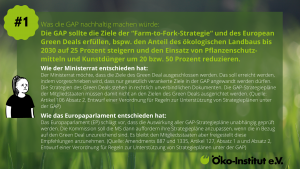
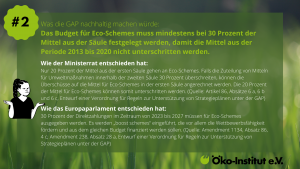



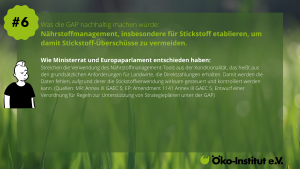
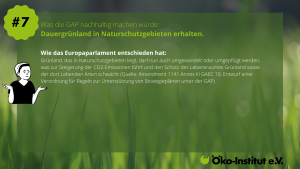

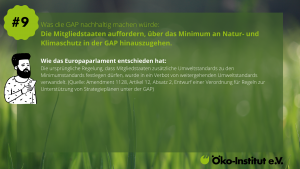
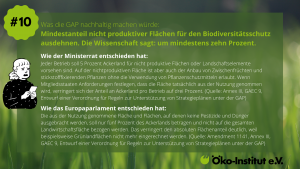
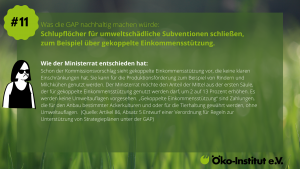 Alle elf Maßnahmen in einem Dokument (PDF)
Alle elf Maßnahmen in einem Dokument (PDF)
Anke Herold ist Geschäftsführerin des Öko-Instituts. Sie war Verhandlungsführerin für die EU zum Thema Transparenz unter der Klimarahmenkonvention der Vereinten Nationen (UNFCCC). Ihr Arbeitsschwerpunkt ist die europäische und internationale Klimapolitik, insbesondere die Ausgestaltung des internationalen Klimaregimes.
English version
EU agricultural policy: A change to destructive funding practices is long overdue
The Oeko-Institut’s Executive Director Anke Herold comments in her blog article on why the current renegotiation of EU agricultural subsidies will not contribute to climate change mitigation. And yet there is no other sector where the EU has such a major and direct influence on emissions as in agriculture.
[caption id="attachment_1322" align="alignright" width="300"] Anke Herold is Executive Director of the Oeko-Institut.[/caption]
Anke Herold is Executive Director of the Oeko-Institut.[/caption]
Following Commission President von der Leyen’s effusive statements about more ambitious climate targets for the EU, many people were hoping that words would finally be followed by action. However, their optimism proved to be premature: the decisions adopted by Europe’s agriculture ministers and the European Parliament on the Common Agricultural Policy (CAP) in late October 2020 are clearly a retrograde step, not only for the climate but also for biodiversity, wetland protection and animal welfare. Since then, some tough wrangling over tentative improvements has begun in the trilogue between the Commission, the Council and the European Parliament.
There is no other sector where the EU has such a major and direct influence on emissions as in agriculture:
The Common Agricultural Policy (CAP) is the area of European Union policy that sets the framework for payments to farms. Some 387 billion euros in CAP funding will be distributed over the next seven years – one third of the EU’s total budget.
In no other sector is the level of completely avoidable emissions as high as in agriculture. Approximately 40% of agricultural emissions come from nitrogen surpluses. It has been recognised for decades that in Germany – and Europe as a whole – more nitrogen is applied to fields than crops need for growth.
No other sector has as much carbon storage potential as agriculture. With the rewetting of drained wetland and peatland and appropriate protection and management of their carbon-rich soils, there is potential to capture large amounts of CO2 from the atmosphere and make progress on protecting nature and biodiversity at the same time.
The draft legislation on the CAP, which is now in the final stages of negotiation, will not put agriculture on a pathway that is compatible with the goal of climate neutrality by 2050.
The architecture: the two pillars of the Common Agricultural Policy
- Direct payments
Despite a proposed 11% reduction in Pillar 1, i.e. direct payments, this will continue to account for the largest share of the CAP budget. 60% of direct payments will still be coupled to farm size and output. One third of these direct payments goes to just 1.5% of beneficiaries.
The major paradox is that most of this funding will continue to be allocated as area-based direct payments. Even with conditionality, direct payments are not suitable as a means to progress climate change mitigation, animal welfare or environmental protection, as practical experience over many years has shown.
Eco-schemes: under-funded and watered down
Only around 30% of the direct payments budget is likely to be reserved for environmental and climate programmes known as eco-schemes. In fact, the Council wants to ringfence just 20% of the direct payment budget for eco-schemes under the CAP reform proposals. These “eco-schemes” are 12-month programmes to be established by the Member States. Farmers will receive payments from Pillar 1 for voluntarily implementing these measures. Designing the eco-schemes is largely a matter for the Member States.
Diverging from the Commission proposal, the Council wants the eco-schemes to be introduced post-2025. In other words, climate action and environmental protection will be pushed back even further into the future.
So what will count as environmental protection for the purpose of the eco-schemes? This has been watered down by both the Council and the European Parliament. Funding will be coupled to attainment of other goals: according to the European Parliament’s proposal, the environmental measures should simultaneously enhance the economic performance of farmers. The list of agri-environmental measures has lengthened considerably, with the inclusion of measures whose positive environmental impacts are disputed. For example, financial support is to be provided for precision farming; granted, this system of agriculture makes more targeted use of pesticides, but it does not aim to reduce these inputs or restrict their use in sensitive areas. The European Parliament would also like to include animal welfare measures in the eco-schemes, but fails to make provision for an increase in funding.
- Payments for rural development
The second pillar of the CAP aims inter alia to support rural development. Agri-environmental-climate measures are included in this pillar in the current CAP. They are financed by the European Agricultural Fund for Rural Development, with a requirement for regional or national co-funding. Under the current proposal, at least 30% of Pillar 2 funding must be spent on agri-environmental- climate measures, organic farming or payments within the Natura 2000 framework. Natura 2000 is an EU-wide network of protected areas that supports the conservation of threatened or typical habitats and species.
This second pillar offers much more potential for climate and environmental protection but receives much less funding.
Indeed, under the latest decisions, 5% of Pillar 2 funding can be shifted to Pillar 1.
Key innovation: Member States should produce CAP Strategic Plans
A key innovation in this CAP reform is that Member States should undertake cross-pillar strategic planning and produce CAP Strategic Plans, which will be reviewed and approved by the Commission.
As is so often the case, in the 300+ pages of this proposal for a regulation establishing rules on support for strategic plans under the Common Agricultural Policy (CAP Strategic Plans), the devil is in the numerous details and minor amendments, which we summarise in the list below. There is rarely any public discussion of these important and detailed provisions.
In no other sector have so many sustainable solutions for environmentally compatible production been available for so long. There is no need for ground-breaking new technologies or countless new inventions. Environmentally friendly farming would also be more socially sustainable, with less restructuring away from individual farms towards corporate agri-businesses. All it would take is a long overdue change to the currently destructive funding practices.
Current plans for agricultural subsidies mean that the Green Deal is not credible
The worrying scenario at present is that for the next seven years, almost 360 billion euros in subsidies will continue to be coupled to farming practices that destroy the climate and biodiversity, with far too little expenditure on organic farming, climate action, nature conservation and animal welfare. The environmental NGOs and Green MEPs have urged the Commission to scrap the entire CAP proposal. However, the prospects of a completely new proposal being presented are vanishingly small: Commission President von der Leyen has already ruled out this option.
Renegotiating the CAP on the basis of a completely new proposal would also be extremely time-consuming and is therefore an unrealistic prospect, given that the current system of agricultural subsidies expires at the end of 2022. Let’s hope that Vice-President Timmermans will indeed push for some positive changes, honouring his solemn assurances to NGOs and even Greta Thunberg herself. However, the negotiations are headed by the Agriculture Commissioner, Janusz Wojciechowski from Poland, and German Agriculture Minister Julia Klöckner, who does not see any need for more action to protect the climate and environment. Unless significant improvements to the existing draft are achieved in the final rounds of the trilogue, the Commission’s plans for implementing the Green Deal will forfeit much of their credibility.
Implementing the CAP in Germany
CAP Strategic Plans will now have to be produced at the national level. Much will depend, therefore, on the action taken at federal and state (Land) level, where the EU legislation offers more leeway than before. In mid-November 2020, the Conference of Environment Ministers of the German Federation and Länder announced plans to draft some key points on the national implementation of the reform, instead of leaving it to the agriculture ministers. But will the Federal Government and the Länder genuinely be able to go beyond the minimum? That will depend on the final compromise reached in Brussels. As it stands, the current draft legislation excludes the possibility for Member States to adopt more ambitious measures than those provided for in the CAP.
11 Measures to make the Common Agricultural Policy (CAP) sustainable:
#1 What would make the CAP sustainable?
The Common Agricultural Policy (CAP) should integrate the objectives from the Farm to Fork Strategy and the European Green Deal, such as increasing the share of organic farming to at least 25% of the EU’s agricultural land by 2030 and reducing the use of pesticides by 50% and fertilisers by 20% by the same date.
What has the Council decided?
The Council is in favour of excluding Green Deal objectives. This is to be achieved by stipulating that only the objectives set out in applicable legislation may be pursued in the CAP. The Green Deal strategies are set out in legally non-binding documents. That means that Member States’ CAP Strategic Plans do not have to be aligned with Green Deal objectives. (Source: Article 106(2), Proposal for a Regulation establishing rules on support for strategic plans to be drawn up by Member States under the Common Agricultural Policy)
What has the European Parliament decided?
The European Parliament (EP) is proposing an independent assessment of the impact of all the national CAP strategic plans. The Commission would then request Member States to modify their CAP Strategic Plans if they fall short of the ambition of the European Green Deal. However, it is up to the Member States to take these recommendations into account. (Source: Amendments 987 and 1335, Article 127, paragraph 1 a and paragraph 2, Proposal for a Regulation establishing rules on support for strategic plans to be drawn up by Member States under the Common Agricultural Policy)
#2 What would make the CAP sustainable?
The budget for eco-schemes must be set at a minimum 30% of funding under the pillar to avoid undercutting the funding level for the period 2013-2020.
What has the Council decided?
Only 20% of the Pillar 1 budget is to be ringfenced for eco-schemes. If the allocation of funding for environmental measures under Pillar 2 exceeds 30%, the surplus may count towards the funding of eco-schemes under Pillar 1. This means that in practice, the 20% budget for eco-schemes can be undercut. (Source: Article 86, paragraphs 6 a, 6 b and 6 c, Proposal for a Regulation establishing rules on support for strategic plans to be drawn up by Member States under the Common Agricultural Policy)
What has the European Parliament decided?
30% of direct payments for the period 2023 to 2027 must be spent on eco-schemes. “Boost schemes” will be introduced, mainly to increase competitiveness, to be funded from the same budget. (Source: Amendment 1134, Article 86(4c); Amendment 238, Article 28a, Proposal for a Regulation establishing rules on support for strategic plans to be drawn up by Member States under the Common Agricultural Policy)
#3 What would make the CAP sustainable?
Establish effective environmental criteria for eco-schemes.
What has the Council decided?
The Council is proposing expanding the scope of the eco-schemes, so that they also contribute to local development in rural areas, the bio-economy and sustainable forestry and to objectives relating to food, health and animal welfare. This means that less money is available to support the specific environmental- and climate-related objectives, as total funding will not be increased. (Source: Article 28(3), Proposal for a Regulation establishing rules on support for strategic plans to be drawn up by Member States under the Common Agricultural Policy)
What has the European Parliament decided?
Eco-schemes should contribute to the achievement of environmental objectives, while maintaining and enhancing the economic performance of farmers (ensure farm incomes, enhance market orientation, increase competitiveness). This will make many environmental measures impossible to implement and reduce the remaining eco-schemes’ protective effect on the environment. (Source: Amendment 1131, Article 28b(1), Proposal for a Regulation establishing rules on support for strategic plans to be drawn up by Member States under the Common Agricultural Policy)
#4 What would make the CAP sustainable?
Eco-schemes must start from 2023.
What has the Council decided?
There will be a two-year pilot phase for eco-schemes, which will not become binding until 2025. Funds not disbursed by 2025 do not have to be spent on environmental measures. (Source: Article 86, paragraphs 6 a and 6 b, Proposal for a Regulation establishing rules on support for strategic plans to be drawn up by Member States under the Common Agricultural Policy)
#5 What would make the CAP sustainable?
Reward Member States if they spend more than the EU minimum on environmental and climate measures.
What has the European Parliament decided?
The European Parliament has stipulated new limits on the maximum amounts of support provided for agri-environment-climate commitments under Pillar 2. This is to avoid some Member States proceeding more rapidly than the EU average. (Source: Amendment 1133, Article 65(3), Proposal for a Regulation establishing rules on support for strategic plans to be drawn up by Member States under the Common Agricultural Policy)
#6 What would make the CAP sustainable?
Establish nutrient management, especially for nitrogen, in order to avoid nitrogen surpluses.
What have the Council and the European Parliament decided?
The use of the nutrient management tool is no longer part of the conditionality, i.e. the basic requirements for farmers receiving direct payments. This means that there will be insufficient data available for effective control and management of nitrogen use. (Sources: Council: Annex III GAEC 5; EP: Amendment 1141, Annex III GAEC 5, Proposal for a Regulation establishing rules on support for strategic plans to be drawn up by Member States under the Common Agricultural Policy)
#7 What would make the CAP sustainable?
Maintenance of permanent grassland in nature protection areas.
What has the European Parliament decided?
Grassland in nature protection areas may now be converted or ploughed, which will increase CO2 emissions and weaken the protection of grassland and its habitat function, along with the species that depend on it (Source: Amendment 1141, Annex III, GAEC 10, Proposal for a Regulation establishing rules on support for strategic plans to be drawn up by Member States under the Common Agricultural Policy)
#8 What would make the CAP sustainable?
Rewetting of drained wetlands and peatlands, conservation of carbon-rich soils.
What has the Council decided?
Minimum protection for wetlands and peatlands to come into effect no later than 2025. Minimum requirements to be established by Member States. (Source: Annex III, GAEC 2, Proposal for a Regulation establishing rules on support for strategic plans to be drawn up by Member States under the Common Agricultural Policy)
What has the European Parliament decided?
In addition to protecting wetlands and peatlands, support should be provided for maintaining and enhancing existing wetland and peatland areas. This may also apply to drained wetland, creating scope to support continued drainage activities. As this is the largest source of greenhouse gases in the agriculture sector, however, the protective effect is thus reversed. (Source: Amendment 1141, Annex III, GAEC 2, Proposal for a Regulation establishing rules on support for strategic plans to be drawn up by Member States under the Common Agricultural Policy)
#9 What would make the CAP sustainable?
Encourage Member States to exceed the minimum nature conservation and climate action commitments set out in the CAP.
What has the European Parliament decided?
The original provisions allowing Member States to define additional environmental standards that go beyond the minimum standards have given way to a ban on more ambitious standards. (Source: Amendment 1128, Article 12(2), Proposal for a Regulation establishing rules on support for strategic plans to be drawn up by Member States under the Common Agricultural Policy)
#10 What would make the CAP sustainable?
Extend the minimum percentage of the non-productive area in the interests of biodiversity. Scientists are calling for a minimum 10%.
What has the Council decided?
Each farm should set aside a 5% minimum share of arable land as non-productive areas or for retention of landscape features. However, certain productive uses (catch crops or nitrogen-fixing crops, cultivated without plant protection products) are permitted on these non-productive areas. If Member States establish a requirement that these areas are to be taken out of use, the minimum share of arable land per farm is reduced to 3%. (Source: Amendment 1141, Annex III, GAEC 9, Proposal for a Regulation establishing rules on support for strategic plans to be drawn up by Member States under the Common Agricultural Policy)
What has the European Parliament decided?
The area taken out of productive use and areas where no pesticides and fertilisers may be applied will amount to just 5% of arable land rather than being based on total agricultural area. This greatly reduces the total area in absolute terms because grassland, for example, is no longer included. (Source: Amendment 1141, Annex III, GAEC 9, Proposal for a Regulation establishing rules on support for strategic plans to be drawn up by Member States under the Common Agricultural Policy)
#11 What would make the CAP sustainable?
Close loopholes for environmentally harmful subsidies, e.g. via coupled income support.
What has the Council decided?
The Commission proposal includes provisions on coupled income support with no clear restrictions. This form of aid can be used, for example, to support production in the beef and dairy sectors. The Council is in favour of increasing the share of funds that can be used for coupled income support under Pillar 1 by 2% to 13%. No environmental conditionality is envisaged. “Coupled income support” payments are granted as aid to the production of certain arable crops or to livestock farming, without any environmental conditionality applying. (Source: Article 86(5), Proposal for a Regulation establishing rules on support for strategic plans to be drawn up by Member States under the Common Agricultural Policy)
All 11 measures in one document.
Anke Herold is the Executive Director of the Oeko-Institut. She was previously an EU negotiator on the topic of transparency under the United Nations Framework Convention on Climate Change (UNFCCC). Her main area of work is European and international climate policy, particularly the design of an international climate regime.
